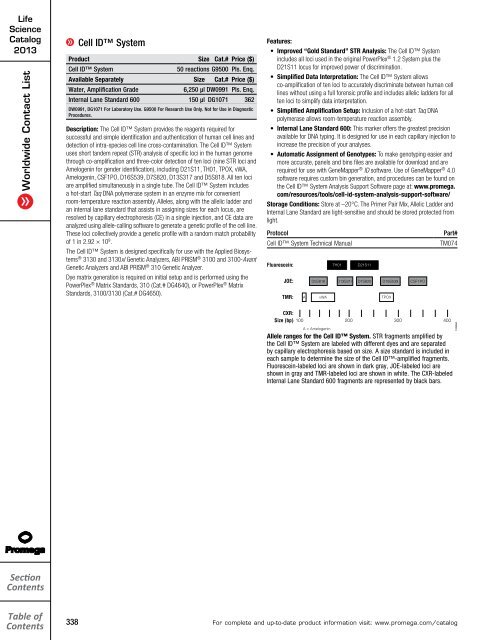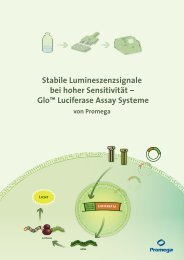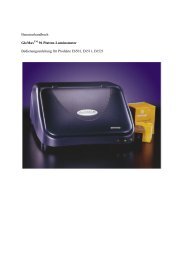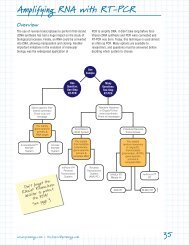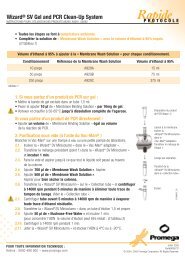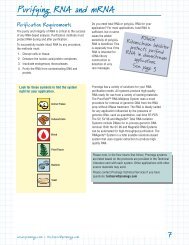2013 Promega catalogue
2013 Promega catalogue
2013 Promega catalogue
Create successful ePaper yourself
Turn your PDF publications into a flip-book with our unique Google optimized e-Paper software.
Life<br />
Science<br />
Catalog<br />
<strong>2013</strong><br />
Worldwide Contact List<br />
Cell Signaling<br />
Cell ID System<br />
Product Size Cat.# Price ($)<br />
Cell ID System<br />
50 reactions G9500 Pls. Enq.<br />
Available Separately Size Cat.# Price ($)<br />
Water, Amplification Grade<br />
6,250 μl DW0991 Pls. Enq.<br />
Internal Lane Standard 600 150 μl DG1071 362<br />
DW0991, DG1071 For Laboratory Use. G9500 For Research Use Only. Not for Use in Diagnostic<br />
Procedures.<br />
Description: The Cell ID System provides the reagents required for<br />
successful and simple identification and authentication of human cell lines and<br />
detection of intra-species cell line cross-contamination. The Cell ID System<br />
uses short tandem repeat (STR) analysis of specific loci in the human genome<br />
through co-amplification and three-color detection of ten loci (nine STR loci and<br />
Amelogenin for gender identification), including D21S11, TH01, TPOX, vWA,<br />
Amelogenin, CSF1PO, D16S539, D7S820, D13S317 and D5S818. All ten loci<br />
are amplified simultaneously in a single tube. The Cell ID System includes<br />
a hot-start Taq DNA polymerase system in an enzyme mix for convenient<br />
room-temperature reaction assembly. Alleles, along with the allelic ladder and<br />
an internal lane standard that assists in assigning sizes for each locus, are<br />
resolved by capillary electrophoresis (CE) in a single injection, and CE data are<br />
analyzed using allele-calling software to generate a genetic profile of the cell line.<br />
These loci collectively provide a genetic profile with a random match probability<br />
of 1 in 2.92 × 10 9 .<br />
The Cell ID System is designed specifically for use with the Applied Biosystems<br />
® 3130 and 3130xl Genetic Analyzers, ABI PRISM ® 3100 and 3100-Avant<br />
Genetic Analyzers and ABI PRISM ® 310 Genetic Analyzer.<br />
Dye matrix generation is required on initial setup and is performed using the<br />
PowerPlex ® Matrix Standards, 310 (Cat.# DG4640), or PowerPlex ® Matrix<br />
Standards, 3100/3130 (Cat.# DG4650).<br />
Features:<br />
• Improved “Gold Standard” STR Analysis: The Cell ID System<br />
includes all loci used in the original PowerPlex ® 1.2 System plus the<br />
D21S11 locus for improved power of discrimination.<br />
• Simplified Data Interpretation: The Cell ID System allows<br />
co-amplification of ten loci to accurately discriminate between human cell<br />
lines without using a full forensic profile and includes allelic ladders for all<br />
ten loci to simplify data interpretation.<br />
• Simplified Amplification Setup: Inclusion of a hot-start Taq DNA<br />
polymerase allows room-temperature reaction assembly.<br />
• Internal Lane Standard 600: This marker offers the greatest precision<br />
available for DNA typing. It is designed for use in each capillary injection to<br />
increase the precision of your analyses.<br />
• Automatic Assignment of Genotypes: To make genotyping easier and<br />
more accurate, panels and bins files are available for download and are<br />
required for use with GeneMapper ® ID software. Use of GeneMapper ® 4.0<br />
software requires custom bin generation, and procedures can be found on<br />
the Cell ID System Analysis Support Software page at: www.promega.<br />
com/resources/tools/cell-id-system-analysis-support-software/<br />
Storage Conditions: Store at –20°C. The Primer Pair Mix, Allelic Ladder and<br />
Internal Lane Standard are light-sensitive and should be stored protected from<br />
light.<br />
Protocol<br />
Cell ID System Technical Manual<br />
Fluorescein:<br />
JOE:<br />
TMR:<br />
A<br />
D5S818<br />
vWA<br />
TH01<br />
D21S11<br />
D13S317 D7S820 D16S539 CSF1PO<br />
TPOX<br />
Part#<br />
TM074<br />
CXR:<br />
Size (bp) 100 200 300 400<br />
A = Amelogenin<br />
Allele ranges for the Cell ID System. STR fragments amplified by<br />
the Cell ID System are labeled with different dyes and are separated<br />
by capillary electrophoresis based on size. A size standard is included in<br />
each sample to determine the size of the Cell ID-amplified fragments.<br />
Fluorescein-labeled loci are shown in dark gray, JOE-labeled loci are<br />
shown in gray and TMR-labeled loci are shown in white. The CXR-labeled<br />
Internal Lane Standard 600 fragments are represented by black bars.<br />
7426MA<br />
Section<br />
Contents<br />
Table of<br />
Contents<br />
338<br />
For complete and up-to-date product information visit: www.promega.com/catalog


